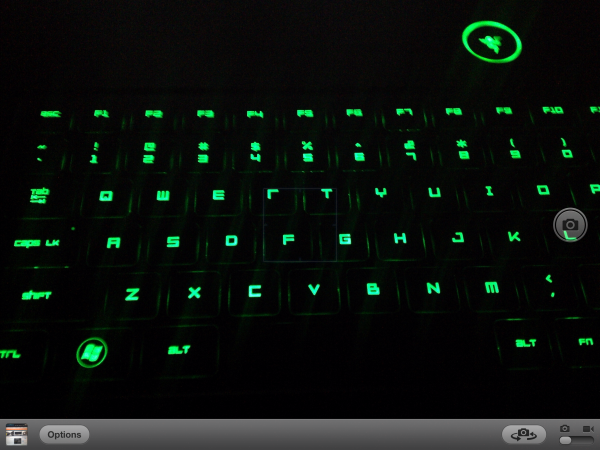The Apple iPad Review (2012)
by Vivek Gowri & Anand Lal Shimpi on March 28, 2012 3:14 PM ESTThe Camera, It's Much Improved
by Vivek Gowri
iOS 5.1 brought with it a number of bugfixes along with a few minor changes to the core entertainment applications (Music, Photos, Videos), but the only real UI change it brought was the redesigned camera application for the iPad. It fixes our biggest complaint with the original—the shutter button’s location in the middle of the settings bar at the bottom of the screen—and ends up being a big improvement from a usability standpoint. The shutter now resides in a floating circular button on the right side of the display, right where your right thumb falls when holding the iPad with two hands. It’s a more intuitive location for the shutter, so taking a picture is a far more natural feeling exercise than it was before. Other than that, the app looks pretty similar—the settings bar now has the still/video slider, front/rear camera switch, an options button, and the link to the photo gallery.
In terms of camera options, there’s only one. You can either have the rule of thirds grid overlay visible or hidden....and that’s it. There’s no other settings for you to change. No exposure, white balance, ISO, shutter speed, or anything else that isn’t the shutter button. Unfortunately, even the HDR mode from the 4 and 4S is nowhere to be found on the iPad. You literally just point and shoot. That’s all there is for you to do.
In our review of the iPad 2, we summed up the cameras with just one word, mediocre. Looking back, I realize now that the word mediocre is a pretty charitable way to describe the iPad 2’s camera situation. Both sensors were borrowed from the iPod touch, and while the VGA front facing camera was acceptable, the rear facing 720p camera was legitimately bad by the standards of a $499 device.
The new iPad fixes that rear camera problem in a big way, with the five element f/2.4 lens and optics borrowed from the iPhone 4S paired with the Omnivision OV5650 CMOS image sensor from the iPhone 4. A quick refresher on specs: 5 megapixels, backside illuminated, 1080p video at 60fps. If you ignore megapixel count, it’s a pretty competitive camera on paper. There’s a lot of recycled parts here, with bits and pieces from other iDevices frankensteined together to come up with a new imaging system for the iPad, but parts-bin raids aren’t bad when the bins being raided from contain top-tier components. The result ends up being pretty good—as a camera, the new iPad is light years ahead of its predecessor in basically every way.
In practice, it’s nothing short of stellar. Image quality is comparable to most high end smartphones, though not quite good enough to be on par with the bleeding edge cameraphones (4S, Nokia N8/N9, HTC Amaze 4G, Galaxy S 2, etc). Interestingly enough, the preview image looks to be running below 30 fps, appearing a little bit choppy at times. This is likely due to the high resolution of the preview and upscaling it to a very high display resolution, but it doesn’t particularly affect image capture. I measured shot to shot time at exactly one second (I had a range between 0.98 and 1.04 seconds, averaged out to 1.0 when factoring in reaction time). That’s about double what Apple claimed for the 4S, and a bit longer than the iPad 2. Granted, the iPad 2’s camera was very quick in part because the amount of processing it takes to capture a 960x720 image is almost zero, with about 13.8% as many pixels as each 2592x1936 image captured by the new iPad.
The focal length is 4.28mm, a bit longer than the iPad 2’s 3.85mm. The difference is actually noticeable; when taking pictures of nearby subjects, you’re sometimes surprised by how magnified the subject appears. However, the camera is good for landscapes, as you can see from the sample gallery. I took the iPad with me on a weekend trip to Victoria, B.C. and used it as my primary camera on the trip. Now, while I wouldn’t trade my SLR for an iPad anytime soon, I can’t deny that the results turned out pretty well. Colours were vibrant, white balance was accurate, and the clouds were nicely highlighted. It’s a quantum leap from the noisy, 0.7MP mess that was the iPad 2 camera. Mouse over the links below to see some comparisons between the cameras on the iPad 2, 3rd gen iPad and TF Prime.

| Apple iPad 2 | Apple iPad (3rd gen) | ASUS TF Prime |
| original | original | original |

| Apple iPad 2 | Apple iPad (3rd gen) | ASUS TF Prime |
| original | original | original |
The new sensor can record 1080p video, up from 720p. Video quality was probably the best aspect of the iPad 2 camera, and it's even better here. Output is recorded at 29.970 fps and encoded in h.264 Baseline with a bitrate of 21Mbps and single channel audio at 64kbps. The recorded video impresses, with crisp detailing and adequate audio quality from the single mic.
The front facing camera keeps the Omnivision OV297AA sensor from the iPad 2, and as such, image and video quality remain unchanged. It’s not necessarily a bad thing, since it remains adequate for FaceTime and Skype, but it would have been nice to see an update to an HD-quality webcam up front.
With augmented reality apps, I’m starting to see the benefit of rear cameras on tablets. For example, the Yelp app, which takes location and compass data to display what restaurants are the direction the iPad is pointing, with a real-time street view of the search results. It’s not necessarily the most useful way to use the rear facing camera in an AR application, but overall it’s an idea that has potential. Apple also tells us that its business and education customers see usefulness in the iPad's rear facing camera as they can use it to quickly document something while using the iPad as a productivity tool. As a consumer, you’re going to get weird looks if you’re using the iPad to take pictures though, it’s a relatively comical sight.
And that’s really the problem: from an ergonomic standpoint, smartphones are just so much easier and more comfortable to use as cameras. And because the imaging hardware is so similar, I’m not sure I see the real benefit of having a rear facing camera on a tablet except in very specific use cases.

























234 Comments
View All Comments
zanon - Wednesday, March 28, 2012 - link
In the article:The higher resolution does make smaller fonts readable. For something like an SSH session, that really will mean significantly more stuff can be on a screen at once.
MobiusStrip - Thursday, March 29, 2012 - link
A more useful change would be abandoning the ridiculous glossy screens. It's sad that Apple takes its cues from the plastic schlock being peddled at Best Buy, and participates in this fraud of shoving glossy screens down customers' throats.repoman27 - Thursday, March 29, 2012 - link
The plastic schlock at Best Buy has a glossy plastic film applied to a cheap TN panel. Apple puts a piece of glass in front of their much more expensive IPS panels to protect them. The only way to make that glass (or the glass of the LCD panel itself) matte would be to apply an antiglare plastic film coating to the glass. These films have drawbacks (they block and scatter light making small details and text blurry.) The drawbacks become more exaggerated the farther the front surface of the glass is from the plane of the actual LCD.But you're right, it's probably Apple copying the design language of sub $500 laptops in order to somehow defraud the general public and force their customers to buy the products they actually produce.
And seeing as how this discussion is about the new iPad screen, I'd like to point out that you're complaining about the lack of an antiglare coating on a touchscreen device... Strong work.
Sabresiberian - Thursday, March 29, 2012 - link
How is it fraud? Apple isn't, like, saying their screens are anti-reflective and then giving you totally reflective glossy screens.Many people prefer a glossy screen and simply aren't bothered by background reflections.
;)
Henk Poley - Monday, April 2, 2012 - link
Yes, Apple really should use Schott Conturan/Amiran/Mirogard antireflective technology.btw, not-glossy does not mean matte. Air is not matte either. Glass can be see-through too ;)
Watwatwat - Monday, April 2, 2012 - link
Nope, steve gibson has tested even using screen protectors on the new ipad vs not, it seems to affect the resolution at that level, matte might not be a good idea at all for high density display.KoolAidMan1 - Thursday, March 29, 2012 - link
I wasn't initially blown away, but then after a day of using it every other display seemed bad in comparison. It is one of those things you didn't realize was needed until using it, now I want very high DPI in all of my monitors.menting - Wednesday, March 28, 2012 - link
Is it just me, or do Shadowgun and GTA screenshots look more detailed in Transformer Prime than in the iPad?menting - Wednesday, March 28, 2012 - link
nm..i just noticed that it's scaled up in new ipad, so it's definitely not as sharp.However, how can fps be fairly compared in this case then?
TheJian - Wednesday, March 28, 2012 - link
Basically because of the way Nvidia and Apple approach games so far, you can expect games on Tegra3 to just look better as they seem to aim for more graphics and fewer games (they spend money on fewer projects that produce better results), as opposed to apple who spreads the wealth but just ends up with more cannon fodder if you ask me :) You should get more variety on Apple I'd guess, but a better experience with fewer choices on Tegra3/Android. I like QUALITY over QUANTITY personally and hope Apple leans the way of Nvidia in the future. I would rather have 10 games that I'd play for weeks or months (if I'm playing on my hdtv through one of these I want better water, buildings etc) rather than games I fire up for less than 20 minutes as their just another angry birds variant and arguably useless on your TV.I want these devices to KILL the consoles next year and make MS/Nintendo etc give it up in 2015 or whenever the next revs should come. I hope they just realize we won't buy them anymore. DirectX11 on my phone/tablet and probably standard 25x14 resolutions by then (won't all be retina by 2015?) make a console purchase STUPID. This could be the merging of console/pc we need since phones/tablets rev yearly like pc's instead of 10yr console's stuck in stone stagnating gaming. Your phone as a portable console with xbox/ps3/pc gamepad support would be excellent. Pump it out to a monitor and keyboard/mouse setup and you have a notebook replacement too...LOL Now if they'd just put in a few extra cores by then that will disable if on their own screen but turn on when on a larger display like TV/Monitor and we have exactly what we want in both cases :)
Pipe dreams? Retina is here now, and gamepads sort of. Next stop cores that only turn on depending on display output :) Awesome battery on the road, and great power in the dock at home pushing your 27in monitor. :) The 28nm versions by xmas of everyone's chips should come close to console power or surpass them. Interesting times.